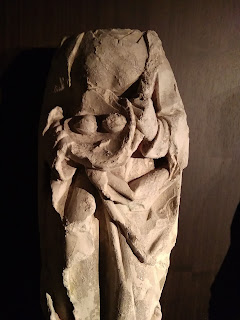In May, I spent a few days in Santiago de Compostela, a city rich in history and a place important to my own academic interests. In future blogposts, I hope to share several details from the Compostela's multilayered past, and I am collecting these posts under the header 'Cantigas de Compostela', an admittedly clumsy alliterative pun on the famous thirteenth-century collections of songs known as the Cantigas de Santa Maria.
The first instalment in this new series is a reflection on a type of mystery specific to the scholarship on the cult of saints. As I was exploring the impressive museum of the cathedral of Santiago de Compostela, I noticed a headless statue carrying two items in a bowl. According to the sign in the museum, the statue is one among several that once decorated one of the cathedral's chapels, and it was made in the middle of the sixteenth century, possibly in a Flemish workshop, or by Flemish masons working in Spain.
The statue has been identified as Saint Lucy, a virgin martyr from Sicily who was believed to have been killed during the Diocletian persecutions of the early fourth century. Her cult was revivified following the publication of Legenda Aurea written by Jacobus de Voragine in the 1260s, and she features in many works of late-medieval art. At the time of writing, I do not know whether the identification of this statue rests on any information outside what the statue itself provides. For instance, whether there are archival material referencing these statues, earlier descriptions of the chapel from when the head was still attached, surviving fragments, or any other indicators that point in this specific directions. If we consider the statue itself, however, things are less clear.
The best argument for Lucy as the saint in question is the the bowl containing two items. According to legend, Lucy was blinded, and her eyes became her defining attribute in art, often shown as presented on a plate or a bowl, as in the case of this statue. However, there is also another candidate, namely Saint Stephen, who was stoned to death according to the account given in Acts, and his main attribute in late-medieval art is a selection of stones. The display of these stones can differ according to the medium or the choice of the artists. In statues, the stones are typically held, whereas in paintings or frescoes the stones can be placed elsewhere, as in the case of Carlo Crivelli's rendition, where the stones are balanced on the saint's head and shoulders. In short, we have two saints who are known by their presentation of round or roundish items, and this is all we have to go on in the case of the statue in the cathedral museum. (The clothes do not yield any clues, as without the original paint, which might have included patterns that could have pointed to a specific gender or social position, they are too generic to allow for any conclusions.)
What about the items themselves? This is, perhaps, the only clue to which we can reasonably cling. Although we should be mindful of the choices of individual artists, or at least different traditions of individual workshops, the number of items is significant. Naturally, Lucy is typically depicted with both her eyes on a plate - even though she is also typically depicted with her eyes in their original place at the same time, because she is a saint and therefore posthumously healed. The stones of Saint Stephen, on the other hand, ordinarily come in slightly higher numbers, either as a pile whose total number is only hinted at by the stones on the top and at the front of the pile, or as three or four held in the saint's hands. While it is possible that an artist or a workshop would depict only two of Saint Stephen's stones, the number does suggest that Lucy might be the correct identification.
Ultimately, however, we do not know, but the case does serve as a good reminder of how crucial iconography is to the navigation of medieval art, and how sometimes the attribute of a saint might be the only thing that allows us to pinpoint the saint's identity.
And was the holy Lamb of God,
On Englands pleasant pastures seen!
- And did those feet, William Blake
On Englands pleasant pastures seen!
- And did those feet, William Blake
søndag 30. juni 2024
Cantigas de Compostela, part 1: Saint Stephen or Saint Lucy?
Etiketter:
Art,
History,
Legenda Aurea,
Medieval,
Saints,
Santiago de Compostela,
Spain,
St. Lucy,
St. Stephen Protomartyr
Abonner på:
Legg inn kommentarer (Atom)



Ingen kommentarer:
Legg inn en kommentar